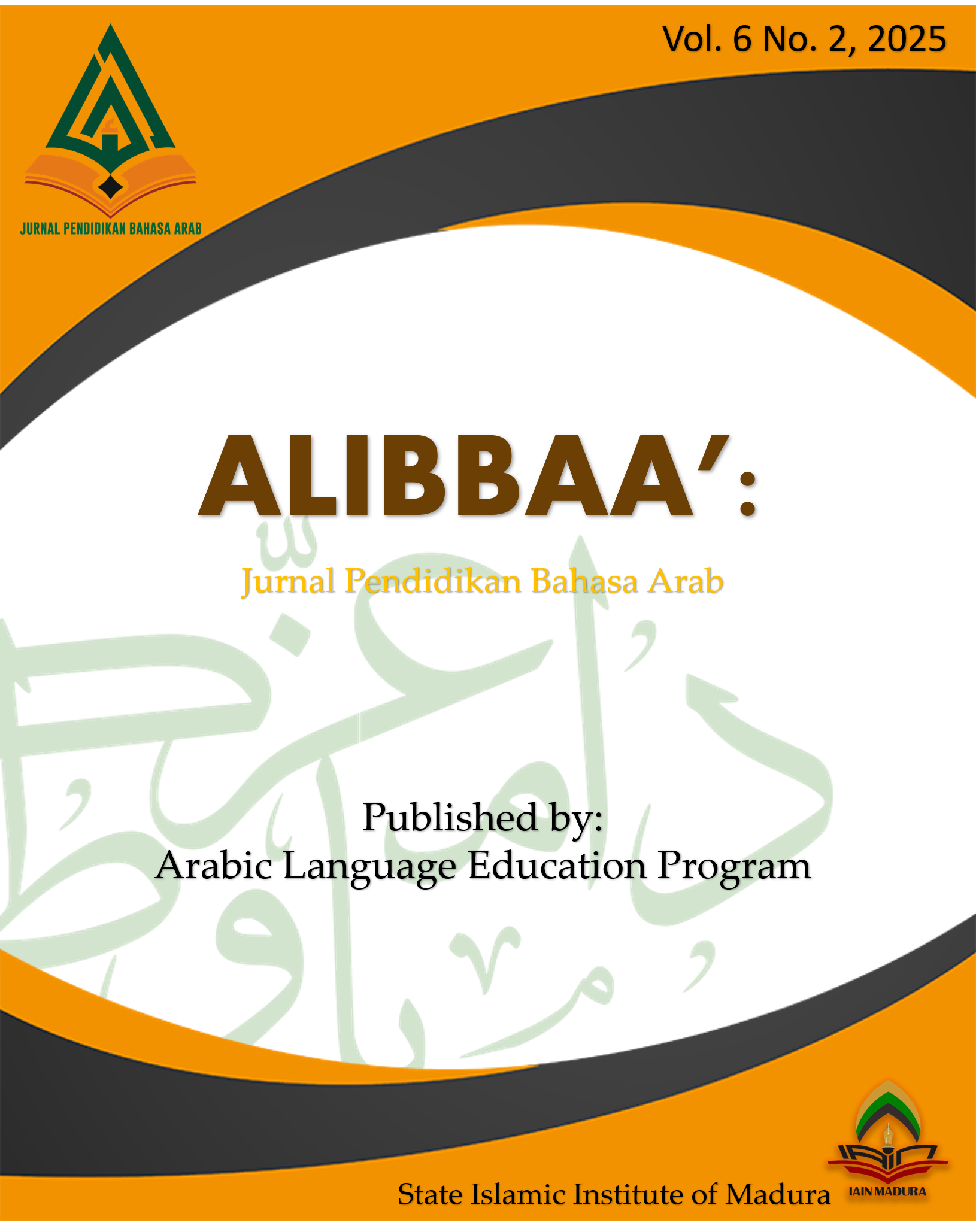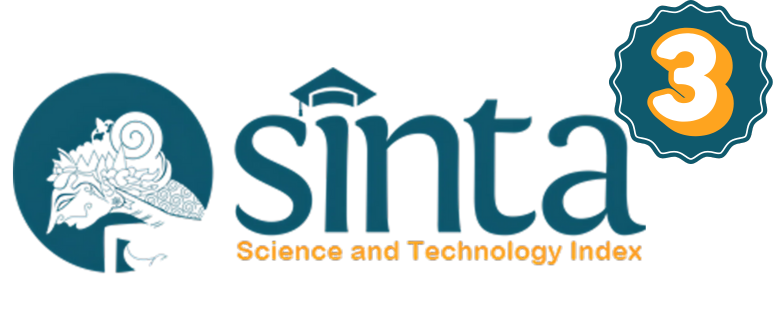Fostering Arabic Speaking Proficiency Through Ahaslides-Based Instructional Materials: A Qualitative Study in Indonesian Secondary Education
 Abstract views: 230
,
Abstract views: 230
,
 pdf downloads: 164
pdf downloads: 164
Abstract
This study aims to explore the implementation of Ahaslides-based instructional materials in the teaching of Arabic speaking skills (maharah al-kalām) among seventh-grade students at MTs Ira Medan. Employing a qualitative approach with a naturalistic research design, the study seeks to understand the teaching process in a contextual and in-depth manner. Data were collected through observations, interviews, and documentation, and analyzed using Miles and Huberman’s interactive model. The findings reveal that the integration of Ahaslides fosters an interactive and engaging learning environment that encourages students’ active participation in speaking Arabic. Digital features such as the spinner wheel, Q&A, and match pairs help build students’ confidence, enhance vocabulary acquisition, and reinforce their understanding of sentence structure. Supporting factors include sufficient school infrastructure, teacher creativity, and student enthusiasm. However, challenges such as limited access to devices and unstable internet connections were also identified. Overall, Ahaslides demonstrated potential effectiveness in promoting Arabic speaking skills and offers an innovative alternative for technology-integrated language instruction.
Downloads
References
Abd al-Hakim, Abd al-Rahman Husain. “Muhaffazât al-Al’âb al-Raqmiyyah (Gamification) fî Ta’lîmi al-Lughah al-’Arabiyyah: Dirâsatu al-Abhâts al-Mansyûrah fî Tathbîqi Muhaffazâti al-Al’âb al-’Arabiyyah fî Indûnîsiyâ.” Alibbaa’: Jurnal Pendidikan Bahasa Arab 5, no. 1 (2024): 1–29.
Ahmad Zaini. إعداد المواد التعليمية النحوية لترقية مهارة الكلام على أساس التعليم الذاتي بدورة أوشيان عربية ياري. Undergraduate thesis, Universitas Islam Negeri Maulana Malik Ibrahim Malang, 2023.
Ainin, M., Ahsanuddin, M., Asrori, I., and F. Mahmud Adam Ibrahim. “Designing Online-Based Independent Learning Network for the Development of Arabic Language Research Methodology (ALRM) at State University of Malang, Indonesia.” Journal of Education and E-Learning Research 7, no. 1 (2020): 7–14. https://doi.org/10.20448/journal.509.2020.71.7.14.
Akmaliyah, A., Hudzaifah, Y., Ulfah, N., and M. I. Pamungkas. “Child-Friendly Teaching Approach for Arabic Language in Indonesian Islamic Boarding School.” International Journal of Language Education (2021): 501–514. https://doi.org/10.26858/ijole.v5i1.15297.
Albantani, A. M., and A. Madkur. “Teaching Arabic in the Era of Industrial Revolution 4.0 in Indonesia: Challenges and Opportunities.” ASEAN Journal of Community Engagement 3, no. 2 (2019). https://doi.org/10.7454/ajce.v3i2.1063.
Annida Zulfa, Hamsi Mansur, Monry Fraick Nicky Gillian Ratumbuysang, Martine Warren, and Terry Harris. “Developing an Innovative Board Game Using a Cooperative Learning Approach to Foster Interest in Learning Arabic.” Alibbaa’: Jurnal Pendidikan Bahasa Arab 6, no. 1 (2025): 99–119. https://doi.org/10.19105/ajpba.v6i1.17834.
Azzouz Boudadi, N., and M. Gutiérrez-Colón. “Effect of Gamification on Students’ Motivation and Learning Achievement in Second Language Acquisition within Higher Education: A Literature Review 2011–2019.” The EuroCALL Review 28, no. 1 (2020): 40. https://doi.org/10.4995/eurocall.2020.12974.
Bailey, D., Almusharraf, N., and R. Hatcher. “Finding Satisfaction: Intrinsic Motivation for Synchronous and Asynchronous Communication in the Online Language Learning Context.” Education and Information Technologies 26, no. 3 (2021): 2563–2583. https://doi.org/10.1007/s10639-020-10369-z.
Dehghanzadeh, H., Fardanesh, H., Hatami, J., Talaee, E., and O. Noroozi. “Using Gamification to Support Learning English as a Second Language: A Systematic Review.” Computer Assisted Language Learning 34, no. 7 (2021): 934–957. https://doi.org/10.1080/09588221.2019.1648298.
Eltahir, Mohd. E., Alsalhi, N. R., Al-Qatawneh, S., AlQudah, H. A., and M. Jaradat. “The Impact of Game-Based Learning (GBL) on Students’ Motivation, Engagement and Academic Performance on an Arabic Language Grammar Course in Higher Education.” Education and Information Technologies 26, no. 3 (2021): 3251–3278. https://doi.org/10.1007/s10639-020-10396-w.
Faruq, U. “Ta’lim al-Qira’ah li al-Nathiqin bi Ghair al-‘Arabiyyah bi al-Nushush al-Ashliyyah al-Muhtawiyah ‘Ala al-Tsaqafah al-‘Arabiyyah.” Arabiyatuna: Jurnal Bahasa Arab 7, no. 2 (November 2023): 389. https://doi.org/10.29240/jba.v7i2.6621.
Hadi, N., Alvina, N., and Khaled Radhouani. “Ta’zîzu Dâfi’iyyati Thullâbi Riyâdh al-Athfâl li Tathwîri Mahârât al-Lughah al-’Arabiyyah al-Syafawiyyah min Khilâli Barâmiji al-Ta’lîm al-Mukatstsaf.” Alibbaa’: Jurnal Pendidikan Bahasa Arab 5, no. 2 (2024): 189–214. https://doi.org/10.19105/ajpba.v5i2.12195.
Haniff Mohd Tahir, M., Mohd Ariff Albakri, I. S., Haimi Mohd Adnan, A., Syafiq Ya Shaq, M., and D. S. Mohamad Shah. “The Application of Visual Vocabulary for ESL Students’ Vocabulary Learning.” Arab World English Journal 11, no. 2 (2020): 323–338. https://doi.org/10.24093/awej/vol11no2.23.
Husna, I., Maiza, Z., Febriani, S. R., Dinata, R. S., and F. F. Amri. “Digital Game-based Learning: Exploring the Use of Mobile Legends in Arabic Language Skills.” Al-Ta’rib: Jurnal Ilmiah Program Studi Pendidikan Bahasa Arab IAIN Palangka Raya 12, no. 1 (2024): 1–16. https://doi.org/10.23971/altarib.v12i1.8015.
Ismail, H., Ayoubi, M. el, Qassem, M., and F. al Areefi. “Assessing the Impact of Gamification Tools’ Usability on Student Engagement: A Comparative Study in Engineering Education.” 2024 4th Interdisciplinary Conference on Electrics and Computer (INTCEC) (2024): 1–8. https://doi.org/10.1109/INTCEC61833.2024.10603117.
Kosim, N., Ardiansyah, A. A., Hikmah, H. S., and Yusuf Ali Shaleh Atha. “The Use of the Task-Base Language Teaching (TBLT) Method to Improve Learning Outcomes of Arabic Language Skills.” Alibbaa’: Jurnal Pendidikan Bahasa Arab 5, no. 2 (2024): 144–165. https://doi.org/10.19105/ajpba.v5i2.14804.
Liu, Y., Mishan, F., and A. Chambers. “Investigating EFL Teachers’ Perceptions of Task-Based Language Teaching in Higher Education in China.” The Language Learning Journal 49, no. 2 (2021): 131–146. https://doi.org/10.1080/09571736.2018.1465110.
Mahmudah, M., Nurhanifansyah, N., and S. M. S. bin Khalid. “Psycholinguistic Approaches to Enhancing Arabic Speaking Proficiency through Comic Strips.” Arabiyatuna: Jurnal Bahasa Arab 8, no. 2 (2024): 805–826. https://doi.org/10.29240/jba.v8i2.11349.
Mahir Sya'ban Abd al-Bari. مهارات التحدث العملية والأداء. Oman: Dar Al-Maseerah, 2011.
Matthew B. Miles, A. Michael Huberman, and Johnny Saldaña. Qualitative Data Analysis: A Methods Sourcebook. 3rd ed. Thousand Oaks: SAGE Publications, 2014.
Merriam, S. B. Qualitative Research: A Guide to Design and Implementation. San Francisco: Jossey-Bass, 2009.
Muassomah, M., and I. Abdullah. “Learning with Technology: New Experiences for Indonesian Children During COVID-19.” (2021). https://doi.org/10.2991/assehr.k.210421.120.
Mulyadi, D., Wijayatiningsih, T. D., Singh, C. K. S., and E. F. Prastikawati. “Effects of Technology Enhanced Task-Based Language Teaching on Learners’ Listening Comprehension and Speaking Performance.” International Journal of Instruction 14, no. 3 (2021): 717–736. https://doi.org/10.29333/iji.2021.14342a.
Nilna Karamah. تطوير كتب المفردات اليومية في تعليم مهارة الكلام في معهد الخضيرية المتكاملة لتورنغ جوه مبانج. Undergraduate thesis, Universitas Islam Negeri Maulana Malik Ibrahim Malang, 2021.
Qureshi, M., Mahdiyyah, D., Mohamed, Y., and M. Ardchir. “Scale for Measuring Arabic Speaking Skills in Early Children’s Education.” Journal International of Lingua and Technology 1, no. 2 (2022): 114–130. https://doi.org/10.55849/jiltech.v1i2.81.
Raju, R., Bhat, S., Bhat, S., D’Souza, R., and A. B. Singh. “Effective Usage of Gamification Techniques to Boost Student Engagement.” Journal of Engineering Education Transformations 34, no. 0 (2021): 713. https://doi.org/10.16920/jeet/2021/v34i0/157171.
Suhairi. تعليم مهارة الكلام على نظرية بالمدرسة الإسلامية الحكومية 1 مالانج. Undergraduate thesis, Universitas Islam Negeri Maulana Malik Ibrahim Malang, 2020.
Ulhaq, N., and L. Lubis. “Penyusunan Materi Ajar dalam Rangka Meningkatkan Keterampilan Berbicara Bahasa Arab pada Siswa.” Journal of Education Research 4, no. 3 (2023): 1202–1211. https://doi.org/10.37985/jer.v4i3.361.
Yasin, Z., Anwar, H., and B. Luneto. “Multimedia PowerPoint-Based Arabic Learning and Its Effect to Students’ Learning Motivation: A Treatment by Level Designs Experimental Study.” International Journal of Instruction 14, no. 4 (2021): 33–50. https://doi.org/10.29333/iji.2021.1443a.
Yulia, F., Ali Hasan, E. M. E., Bahri, A. N., Fiqiyah, M., and M. Taufiq. “Effectiveness of Instructional Communication of Mahārah Al-Kalām at Sultan Idris Education University.” Ta’lim al-’Arabiyyah: Jurnal Pendidikan Bahasa Arab & Kebahasaaraban 8, no. 2 (2024): 216–233. https://doi.org/10.15575/jpba.v8i2.39201.
Zayuda, D. N. A., Marliana, I., Suryani, M. W., Ibrahim, H., and S. Nasution. “Eksistensi Mahārah Al-Kitābah dalam Pembelajaran Bahasa Arab.” Counselia: Jurnal Bimbingan Konseling Pendidikan Islam 4, no. 2 (2023): 164–180. https://doi.org/10.31943/counselia.v4i2.117.
Authors who publish with this journal agree to the following terms:
a. Authors retain copyright and grant the journal right of first publication with the work simultaneously licensed under a Creative Commons Attribution License that allows others to share the work with an acknowledgement of the work's authorship and initial publication in this journal.
b. Authors are able to enter into separate, additional contractual arrangements for the non-exclusive distribution of the journal's published version of the work (e.g., post it to an institutional repository or publish it in a book), with an acknowledgement of its initial publication in this journal.
c. Authors are permitted and encouraged to post their work online (e.g., in institutional repositories or on their website) prior to and during the submission process, as it can lead to productive exchanges, as well as earlier and greater citation of published work (See The Effect of Open Access).
Alibbaa': Jurnal Pendidikan Bahasa Arab have CC-BY-SA or an equivalent license as the optimal license for the publication, distribution, use, and reuse of scholarly work.
In developing strategy and setting priorities, Alibbaa': Jurnal Pendidikan Bahasa Arab recognize that free access is better than priced access, libre access is better than free access, and libre under CC-BY-SA or the equivalent is better than libre under more restrictive open licenses. We should achieve what we can when we can. We should not delay achieving free in order to achieve libre, and we should not stop with free when we can achieve libre.

Alibbaa': Jurnal Pendidikan Bahasa Arab is licensed under a Creative Commons Attribution 4.0 International License
You are free to:
- Share — copy and redistribute the material in any medium or format
- Adapt — remix, transform, and build upon the material for any purpose, even commercially.
- The licensor cannot revoke these freedoms as long as you follow the license terms.











